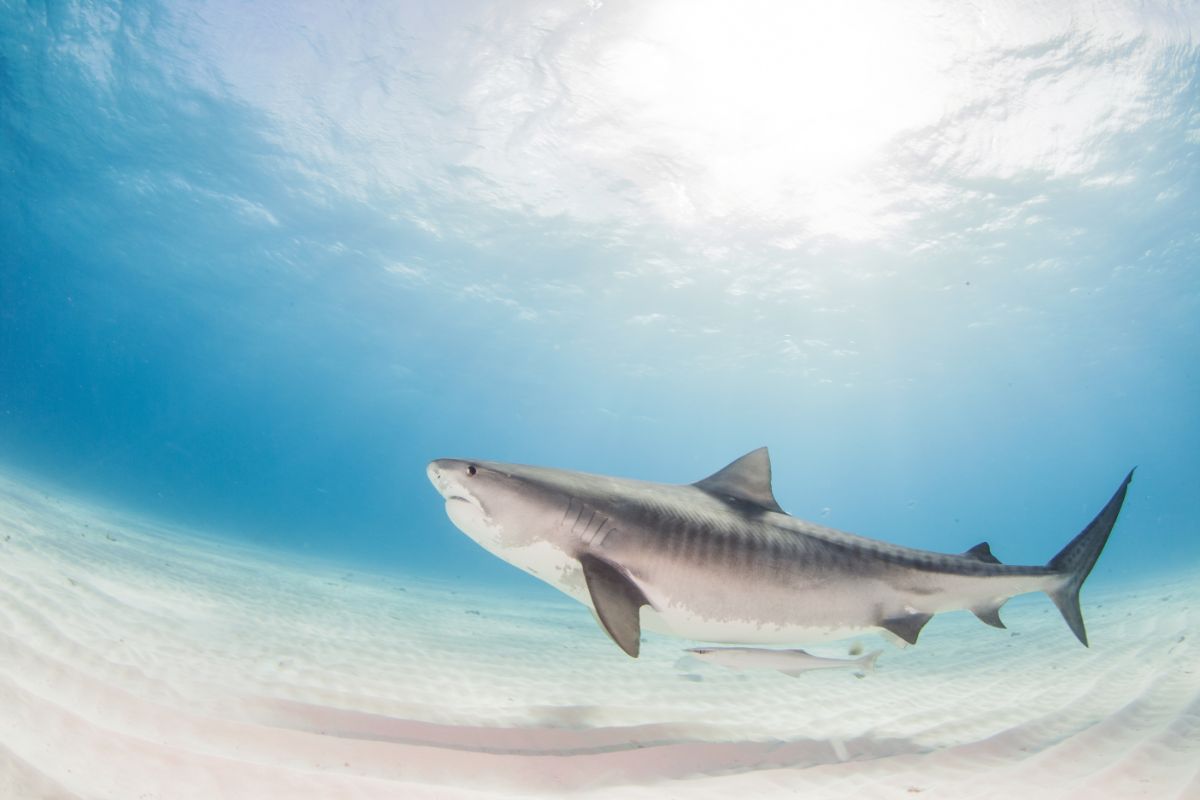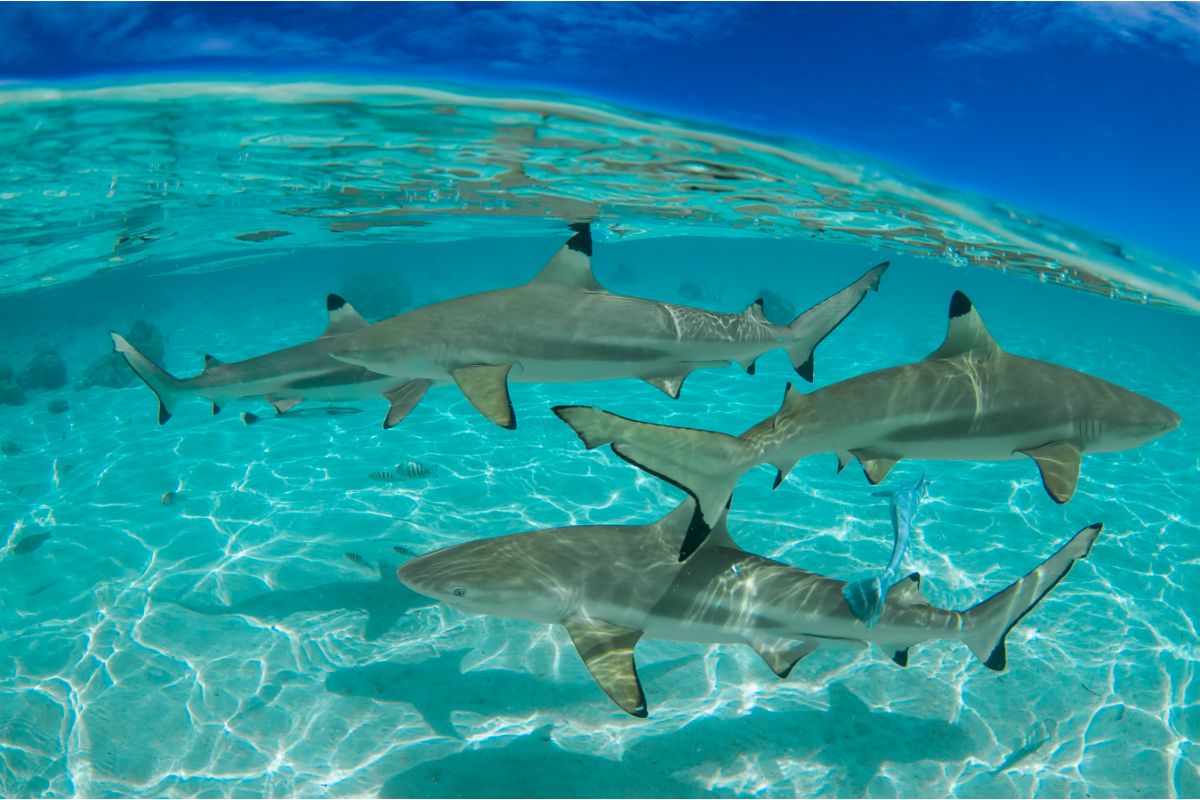You might look at a shark and not even consider if they have a backbone- surely a creature as strong and agile as a shark needs not only just a backbone, but many different bones right?
The answer might actually surprise you!

In this article we’ll be answering this question, and exploring what makes a shark as agile and as deadly as it is, with what it’s got inside.
Do Sharks Have Backbones?
So, do sharks actually have backbones? The answer is yes! They do have a backbone; the backbone of a shark is actually made of cartilage, rather than bone.
The word ‘bone’ in ‘backbone’ can make it look deceiving, but sharks are actually completely boneless creatures. Research has shown that past ancestors of sharks had bones, which were just cartilages that ossified.
What Are Shark’s Backbones Made Of?
So now that we know that sharks do have backbones, we can explain more about the cartilage that makes up the backbone itself.
Cartilage is much lighter than bone, and comes with the added bonus of being flexible, whilst still being able to withstand strong movements and turns, and keep muscle and skin in place whilst doing so.
You might think though that cartilages simply can’t keep up with bone, so why would sharks have no bones in their bodies at all? Let’s take a look.
Why Cartilage?
Cartilaginous backbones benefit the shark in more ways than one where a bony backbone would instead be not nearly as strong for the shark, but why is this?
Cartilages aren’t nearly as strong as bones, but what they lack in strength, they more than make up for in flexibility, and lightweightness which are both features that sharks prize highly.
Cartilages allow them to swim extremely fast, turn quickly to get to their tails, or to escape from a predator, where bones would simply slow the shark down.
These cartilages help the shark’s ability to survive in the water, as it keeps them afloat at all times, and in it’s more vulnerable areas like it’s skull and snout, cartilages in those areas are decisively more sturdy, as they’re coated with extra calcium salts for added protection.
All of these features together mean that sharks always prefer cartilages rather than dense and cumbersome bones.
It also allows energy to be stored in the vertebrae as the vertebral column bends and this in turn compresses the structures that stack to create the spinal column which can store energy if the shark requires it to.
This stored energy source is released at the end of a tailbeat, which scientists believe could be upwards of 10% of the shark’s energy. This in turn helps them to power towards or away from prey or predator.
Did Sharks Used To Have Bones?

Sharks ancestors have been studied enough that we can determine that they had a skeletal system made primarily of bones. But our modern day sharks are completely boneless creatures. So what changed?
Researchers have concluded that these ancestors had bones due to their cartilages ossifying, turning their cartilage into bone over a period of time.
This can be seen even with us humans, as babies have more cartilage immediately after birth, which is why they’re so fragile. As their cartilage ossifies, sturdier and more robust bone takes its place.
Other research goes down another path, which suggests that ancient sharks simply evolved from having bones, to having the much more effective cartilages that they have now.
Either way, it’s clear to see how cartilage is much more effective for a shark.
Do Sharks Have Ribcages?
You might be thinking, because of a shark’s lack of bone, does this mean that they have no ribcage? This is actually true, and can result in some pretty serious problems for sharks when they’re outside of water.
Because of a shark’s lack of ribcage, there’s no internal structure to their body that holds their internal organs in place with the strain of gravity pushing them down.
This can mean that if a shark is left out of water, then they can be crushed under the pressure of their own weight.
Which realistically is a relatively small issue for them as they don’t want to be out of water anyway. But there’s finally a drawback to the cartilage that makes up the insides of the shark.
What Are The Rings On A Shark’s Backbone?
The rings on a shark’s backbone are used by scientists to tell how old a shark is. The longer a shark lives the more bands it gets on its back, and vice versa.
If a shark has 10 bands, then the assumption is that the shark is roughly 10 years old.
This is entirely dependent on the species however, and some species may deposit a single band in 2 years instead of 1, or any other variation, so it’s important to take this information with a grain of salt.
Are Sharks Vertebrates?
To answer this question, the most logical first step is to identify exactly what a vertebrate is. A vertebrate is any animal with a spinal column, which as you can imagine, includes an enormous list of animals.
This is also a relatively simplistic definition of what a vertebrate is, so for more information you should research this further.
Now that we understand the simplistic definition of what a vertebrate is though, we can answer if sharks are vertebrates.
The answer is of course, yes. In order for animals to be classified as vertebrates all they need is a spinal column, and whilst shark’s spinal columns are not made from bone, it still functions in the same exact way that any other vertebrate would use a spinal column.
Despite the fact that sharks don’t have bones, they do in fact have a skeletal system, made completely from cartilage.
The Function Of A Shark’s Vertebrae

Sharks are a meticulously designed species that really show off how long they’ve been on this planet. There’s no part of their body, internally or externally that doesn’t have a distinct advantage for their own survival.
Because of this the function of their vertebrae is to bear the weight that’s placed on their spine, and also to offer a rudimentary form of protection around the spinal cord, which would otherwise be left completely defenseless.
These two purposes are the main functions of the vertebrae.
In cartilaginous fishes, which is a category that sharks fall under, there are two cartilaginous tubes that are present in the vertebrae.
The neural arches form the upper cartilaginous tube, in between the vertebrae are the extra layers of cartilaginous structure that cover the gaps. Which enables it to envelop the spinal cord in one long continuous sheath.
So whilst sharks don’t have any bones, they’re still classed as vertebrates. Scientifically, sharks are actually classified as Chondrichthyes (Cartilaginous fish) belonging to the subphylum Vertebrata and Phylum Chordata.
The backbone of a shark is certainly a real thing, which has specific advantages for the shark.
Advantages/Disadvantages Of A Shark’s Cartilaginous Skeleton
So now that we understand exactly how a shark’s skeleton is built, let’s look through the different advantages and disadvantages of the Cartilaginous skeleton that sharks have developed over the hundreds of millions of years they’ve existed on earth.
Advantages
- Allows for a huge degree of flexibility in the water
- Offers more power in the water
- Gives the shark the option to store power when necessary, perfect for short bursts of extreme speed.
- Cartilage isn’t as hard or protective as bone, so thicker skin is in the way, which helps to prevent minor injuries for the shark
- Shark’s jaws are incredibly flexible and can extend far distances. This is because of the cartilage that makes up their jawbone, which allows for wider bites, and also much more downforce when they close their jaws.
- Cartilage heals much faster than bone.
- Cartilage leaves unlimited space for growth, which is exactly why sharks can progressively get larger and larger, with their skeletons growing much easier than bone would.
Disadvantages
- Outside of the water, sharks are completely useless. Their lack of ribcage means that they’re crushed under their own weight.
- Cartilage can break easier than bone, but it does heal faster.
- The weakness of cartilage can be seen clearly in the vulnerable sections of sharks. Their snouts and heads are relatively weak and can be damaged relatively easily, resulting in death for the sharks.
Final Thoughts
Overall, it’s easy to see why sharks have adapted to use a cartilage skeleton instead of one made from bone, the advantages massively outweigh the disadvantages, and altogether their flexible yet extremely powerful skeletons are a huge reason of why they remain such a dominant predator in our oceans.
Sharks are hundreds of millions of years old, and so they’ve been given more than enough time to evolve into the perfect ocean species to reign supreme, the reason for this? Their highly efficient skeletons.
- Is It Possible For A Shark To Swim Backwards? - August 2, 2022
- Are Leopard Sharks Dangerous? - August 2, 2022
- What Are The Differences Between Shark And Dolphin Fins? - August 1, 2022








